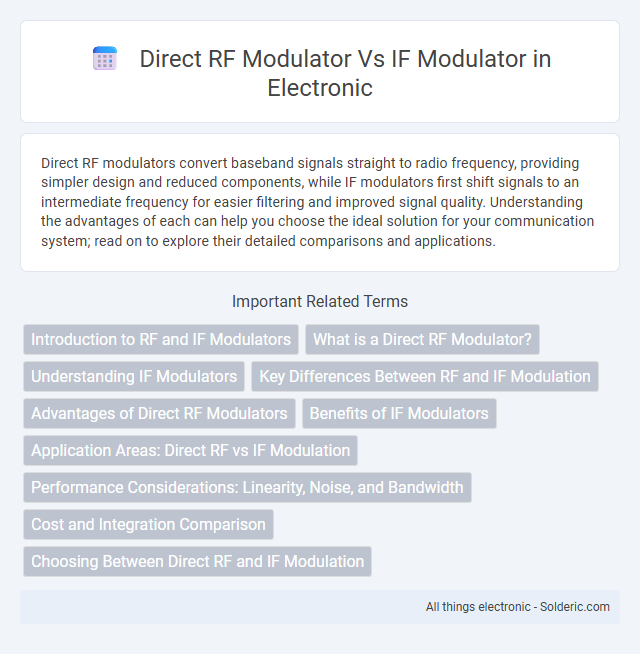Direct RF modulators convert baseband signals straight to radio frequency, providing simpler design and reduced components, while IF modulators first shift signals to an intermediate frequency for easier filtering and improved signal quality. Understanding the advantages of each can help you choose the ideal solution for your communication system; read on to explore their detailed comparisons and applications.
Comparison Table
| Feature | Direct RF Modulator | IF Modulator |
|---|---|---|
| Signal Processing Stage | Directly modulates the Radio Frequency (RF) carrier signal | Modulates the Intermediate Frequency (IF) signal before upconversion |
| Complexity | Lower system complexity, fewer components | Higher complexity due to additional IF stage and upconversion |
| Cost | Generally more cost-effective | Higher cost due to extra components and processes |
| Signal Quality | Potentially more RF interference and spurious emissions | Better signal purity and reduced RF spurs |
| Flexibility | Less flexible for frequency adjustments | More adaptable for multiple frequency outputs |
| Use Cases | Ideal for simple RF transmission systems where cost is a priority | Preferred in professional broadcasting requiring higher signal integrity |
Introduction to RF and IF Modulators
RF modulators directly convert baseband signals into radio frequency signals, enabling broadcast over the airwaves or transmission through antennas, making them ideal for consumer electronics like TVs and video game consoles. IF modulators convert baseband signals to an intermediate frequency, which is then upconverted to the RF band by subsequent stages, commonly used in professional communication systems for improved signal processing and filtering. Understanding the difference helps you choose the right modulator type for optimized signal quality and system design efficiency.
What is a Direct RF Modulator?
A Direct RF Modulator converts baseband audio and video signals directly into a radio frequency (RF) signal for transmission, bypassing intermediate frequency stages. Your choice of a Direct RF Modulator ensures simpler design, reduced component count, and potentially lower system cost compared to IF modulators, which first modulate at an intermediate frequency before upconversion. This technology is commonly used in television broadcast transmitters, cable systems, and RF test equipment where direct RF output is required for compatibility with antennas or RF inputs.
Understanding IF Modulators
IF modulators operate by converting baseband signals to intermediate frequencies before final transmission, offering enhanced selectivity and improved signal quality compared to direct RF modulators. These modulators provide better control over bandwidth and filtering, facilitating reduced interference in complex communication systems. The integration of IF modulators is critical in satellite receivers and advanced radio systems where precise frequency conversion and signal integrity are paramount.
Key Differences Between RF and IF Modulation
Direct RF modulators generate modulated signals at the final radio frequency, enabling immediate transmission with minimal conversion stages, while IF modulators operate at a lower intermediate frequency, requiring subsequent upconversion to the RF band. IF modulation offers improved signal processing flexibility and enhanced selectivity by allowing easier filtering and amplification at the intermediate stage, which is crucial for complex communication systems. Your choice between RF and IF modulation depends on factors such as system complexity, signal quality requirements, and design constraints.
Advantages of Direct RF Modulators
Direct RF modulators offer superior signal integrity by modulating signals directly at the radio frequency, reducing the number of required components and minimizing signal degradation compared to IF modulators. They enable simpler circuit designs with lower latency and improved spectral efficiency, making them ideal for high-frequency and broadband applications. Direct RF modulation also facilitates easier integration with modern digital systems, enhancing overall performance and reliability.
Benefits of IF Modulators
IF modulators offer superior signal stability and reduced interference compared to direct RF modulators, making them ideal for high-quality broadcast applications. Their ability to process signals at intermediate frequencies allows for easier filtering and amplification, improving overall system performance and reliability. If you require precise control and enhanced signal integrity, IF modulators provide a clear advantage in complex communication setups.
Application Areas: Direct RF vs IF Modulation
Direct RF modulators are preferred in applications requiring compactness and direct integration with antenna systems, such as in consumer electronics and wireless communication devices. IF modulators excel in environments where precise signal processing and flexibility are crucial, like satellite communication systems and advanced broadcasting equipment. Understanding your application's signal chain complexity helps determine if a direct RF solution simplifies design or if an IF modulator provides enhanced control and performance.
Performance Considerations: Linearity, Noise, and Bandwidth
Direct RF modulators offer superior linearity and lower noise levels compared to IF modulators, resulting in cleaner signal transmission with minimal distortion. IF modulators typically provide wider bandwidth flexibility but may introduce additional noise and nonlinearities due to the upconversion process. Your choice depends on the specific application requirements, balancing the need for performance accuracy against bandwidth and system complexity.
Cost and Integration Comparison
Direct RF modulators generally offer lower cost and simpler integration due to fewer components and reduced design complexity compared to IF modulators. IF modulators require additional mixers, filters, and local oscillators, increasing both the overall cost and board space needed for implementation. Choosing a direct RF modulator can streamline your design process and reduce system expenses, especially in compact or cost-sensitive applications.
Choosing Between Direct RF and IF Modulation
Choosing between direct RF modulation and IF modulation depends on your system's complexity, frequency requirements, and signal processing capabilities. Direct RF modulators simplify architecture by modulating the signal at the final frequency, ideal for applications requiring fewer components and lower cost, while IF modulators offer better signal quality and flexibility through intermediate frequency processing, suitable for high-performance and multi-standard systems. Evaluating your project's bandwidth, noise tolerance, and integration needs helps determine whether direct RF or IF modulation aligns best with your technical and budgetary constraints.
Direct RF modulator vs IF modulator Infographic

 solderic.com
solderic.com